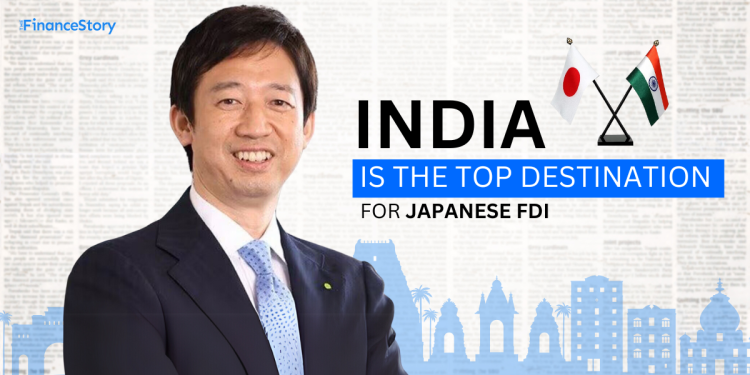India has emerged as a top destination for Japanese Foreign Direct Investment (FDI).
✅ Over $5 billion in Japanese FDI in 2023
✅ India surpasses China in Japanese investments
✅ Key link to Middle Eastern & African markets
Let us understand, Japan’s investment footprint in India
Japan is the 5th largest FDI contributor to India.
- From April 2000 to March 2024, Japan invested around $42.55 billion in India.
- In 2023, India attracted over $5 billion in Japanese FDI while China and Hong Kong totalled $3.6 billion….marking the first time India led in receiving Japanese FDI!
- From January to May 2024, India secured $1.8 billion in FDI from Japan, surpassing China ($1.68 billion) and Vietnam ($897 million).
Japan Bank for International Cooperation (JBIC) – has rated India as the “top long-term investment destination”.
Kenichi Kimura, CEO of Deloitte Japan, highlighted this growing shift during his recent visit to India.
He said India’s growing appeal is thanks to India’s massive market, young talent, and strategic location key link to Middle Eastern and African markets, positioning it as central to their supply chains.
This shift is expected to continue!

Sectors attracting Japanese FDI in India
- Pharmaceuticals
- Infrastructure & Smart Cities: Collaboration on high-speed rail, metro projects, and industrial parks.
- Automobiles & EVs: Suzuki, Toyota, and Honda expanding operations
- Electronics & Manufacturing: Japan’s push for semiconductor and electronics production in India.
- Financial Services & Startups: Growing Japanese VC/PE investments in fintech, SaaS, and tech startups.
A JBIC survey found that 90% of Japanese companies cite India’s market growth potential as the main attraction.
Bangalore: A hotbed for Japanese companies
India hosts 1,072 Japanese companies with 2,542 business bases.
Over the past decade, the number of Japanese establishments in India has grown 11x, showcasing strong investor confidence.
How much has Japan invested in India?
- Fifteen major Japanese companies signed MoUs to invest ₹7,500 crore in Karnataka.
- The investment focuses on automobile manufacturing, industrial automation, and advanced technology.
- These investments are expected to boost employment, innovation, and economic growth in the state.
Key Investment Breakdowns
- Toyota Kirloskar Motor – ₹3,748 crore
- NIDEC Industrial Automation India – ₹600 crore
- Toyota Kirloskar Auto Parts – ₹450 crore
- Toyotetsu India Auto Parts – ₹450 crore
Japanese companies contributing to Karnataka’s industrial landscape include:
- Sango India Automotive Parts
- Aoyama Automotive Fasteners (India)
- NIFCO South India Manufacturing
- Mitsubishi Heavy Industries
- RIX India Manufacturing
Other Companies Signing MoUs:
- JFE Shoji Corporation
- Shindengen India
- Shimadzu Corporation
- Daiki Axis
Hitachi’s Expansion in Karnataka: Hitachi Construction Machinery Co. will set up a Global Competency Center (GCC) plant in Dharwad, further strengthening Karnataka’s position as a hub for advanced manufacturing and industrial growth.
The collaboration between Karnataka and Japanese companies could significantly contribute to the state’s goal of reaching a one trillion-dollar economy by 2032, as reported by The Hindu in 2023.
Also read: India Union Budget 2025-26: Key highlights
Key Drivers of Japanese Investment in India
Massive Consumer Base
Strategic Export Gateway: India provides a launchpad for Japanese firms to expand into high-growth markets in the Middle East and Africa.
Strong Business Networks: India’s well-established business ecosystem enhances ease of expansion.
Government Support: Initiatives like Production-Linked Incentive (PLI) schemes, robust regulatory frameworks, and an improving ease-of-doing-business ranking boost investor confidence.
Tech & Startups: India’s thriving startup ecosystem and its emphasis on innovation and emerging technologies are attracting Japanese capital in fintech, AI, and deep tech sectors.
Most of all, India’s young talent pool also makes it an unbeatable choice for growth.
“India’s appeal lies in its expanding domestic market, the world’s second-largest labor force, and a young population with an average age of 28 years,” Deloitte South Asia CEO Romal Shetty told Mint.
Japan’s long-term investment plans
The Department of Industrial Policy & Promotion (DIPP) has established a dedicated team to streamline investment proposals from Japan.
Named “Japan Plus“, this team includes representatives from the Government of India and METI (Ministry of Economy, Trade and Industry), Government of Japan.
Objectives & Scope of “Japan Plus”
The “Japan Plus” team has been formed following the Indian Prime Minister’s visit to Japan and is tasked with:
- Investment Promotion: Conducting research, outreach, and promotional activities.
- Facilitation & Fast-Tracking: Helping Japanese investors navigate the regulatory landscape in India.
- Handholding Support: Assisting businesses at every stage, from initiation to aftercare.
- Sector-Specific Information: Providing insights on investment opportunities, specific projects, and industrial corridors.
- SME Focus: Identifying and supporting Small and Medium Enterprises (SMEs) from
Wrapping up…
Prime Minister Modi prioritizes FDI, urging states to set clear investment goals.
NITI Aayog is developing an Investment Index to measure state attractiveness.
Union Budget 2024 introduces tax cuts to boost consumption and investment.
India’s strong policies, growing market, and rising Japanese confidence position it as Asia’s top FDI destination.
Continued momentum could reshape the global investment landscape through India-Japan collaboration.
Also read: Mumbai, Fintech Capital of the world? PM Modi unveils a whopping ₹29,400Cr Investment Plan
FAQ
Q: Which sector attracts more FDI in India?
From April 2000-September 2024, India’s service sector attracted the highest FDI equity inflow of 16.0 % amounting to US$ 115.18 billion, followed by the computer software and hardware industry at 15.0%, amounting to US$ 107.07 billion, trading at 7.0% (US$ 46.2 billion), telecommunications at 6.0% (US$ 39.4 billion), and automobile industry at 5.0% (US$ 37.2 billion).
Q: How much Foreign Direct Investments (FDI) has India received?
India’s FDI inflows have increased ~20 times from 2000-01 to 2023-24. According to the Department for Promotion of Industry and Internal Trade (DPIIT), India’s cumulative FDI inflow stood at US$ 1.03 trillion between April 2000-September 2024. The total FDI inflow into India from July 2024 to September 2024 stood at US$ 19.8 billion and FDI equity inflow for the same period stood at US$ 13.6 billion.
Q: Which country has the highest FDI in India?
India also had major FDI inflows during April 2000-September 2024, coming from Mauritius at US$ 177.18 billion with a total share of 25%, followed by Singapore at 24% (US$ 167.47 billion), the USA at 10% (US$ 66.77 billion), the Netherlands at 7% (US$ 52.26 billion), and Japan at 6% (US$ 43.11 billion).
Q: How much has Japan invested in India?
From April 2000 to March 2024, Japan invested around $42.55 billion in India.















